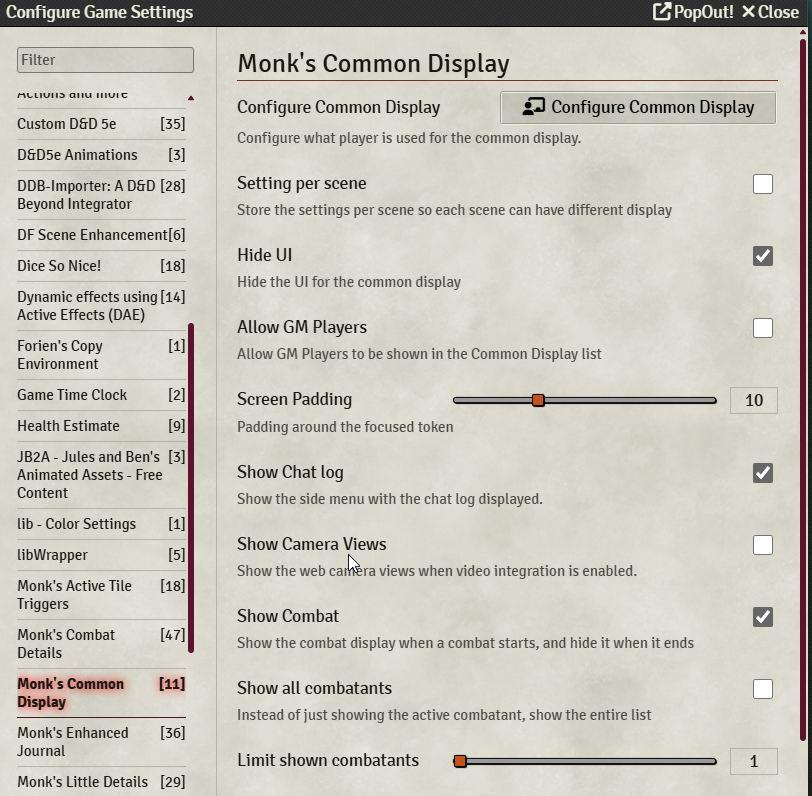Fellow virtual adventurers and organizational enthusiasts! In the bustling environment of a Foundry VTT session, keeping track of various status effects, resources, and conditions affecting multiple tokens can sometimes feel like a visual clutter. This is where modules like Monk’s Common Display (or similarly named modules) come into play, offering a more organized and user-friendly way to present essential information about selected tokens to all participants – players and the Game Master alike.
While the name might initially suggest a focus on the Monk class, the functionality of a “Common Display” module typically extends far beyond a single class. It aims to create a shared, easily digestible view of key information for any selected token, promoting better awareness and communication during gameplay.
The Core Functionality: What Does Monk’s Common Display Typically Do?
At its heart, a module like Monk’s Common Display seeks to address the challenge of information asymmetry on the virtual tabletop. Instead of only the GM having a full overview of token statuses, this module facilitates a shared understanding by:
- Creating a Dedicated Display Area: Introducing a persistent or on-demand panel on the screen that shows relevant information about the currently selected token(s).
- Displaying Key Attributes: Showing vital stats like current Hit Points, temporary HP, Armor Class, and potentially other relevant attributes.
- Listing Active Conditions: Clearly presenting all the active conditions (e.g., Prone, Poisoned, Blessed) affecting the selected token(s) with their icons.
- Tracking Resources: Displaying the current and maximum values of important resources like spell slots, ki points, superiority dice, or any custom resources.
- Showing Passive Effects: Potentially indicating active passive effects or buffs that are currently influencing the token.
- Customizable Information: Often allowing the GM (and sometimes players, depending on the module’s settings) to configure what information is displayed in the common panel.
- Multi-Token Support: Displaying information for multiple selected tokens simultaneously, allowing for a quick overview of a group.
Why is a Common Display Module Beneficial for Your Game?
Integrating a module like Monk’s Common Display can offer several advantages for your Foundry VTT sessions:
- Improved Player Awareness: Players can readily see the status of their own characters and their allies without constantly needing to open character sheets. This promotes better tactical awareness and coordination.
- Enhanced Communication: A shared visual display reduces the need for constant verbal updates on HP, conditions, and resources, leading to smoother and more efficient gameplay.
- Reduced Information Clutter: Consolidating key information into a dedicated panel can declutter the main scene view, making it easier to focus on the map and tokens.
- Streamlined Combat: Quickly assessing the health and status of combatants becomes easier for everyone, speeding up decision-making during encounters.
- Better Immersion: By having readily available information, players can stay more engaged with the game world and the state of their characters.
- Accessibility: Provides a clear and consistent way for everyone to access crucial information, which can be particularly helpful for players with visual impairments or those who prefer a more visual representation of game data.
- GM Oversight: While players benefit, the GM also gains a readily accessible overview of the selected tokens’ states, simplifying encounter management.
How Does Monk’s Common Display Typically Work?
The implementation can vary, but common approaches include:
- Persistent Panel: A panel that remains visible on the screen, updating dynamically as different tokens are selected.
- On-Demand Display: A panel that appears when one or more tokens are selected and disappears when deselected.
- Customizable Placement and Size: Allowing users to adjust the position and size of the display panel to fit their screen layout preferences.
- Integration with Core Foundry Data: Directly pulling information from the actor and token data within Foundry VTT.
- Module Configuration: Providing settings to control which attributes, conditions, and resources are displayed.
Key Features to Look For:
When choosing a Common Display module, consider the following:
- Clarity and Readability: Is the displayed information easy to see and understand at a glance?
- Customization Options: Can you tailor the displayed information to suit your game’s needs?
- Performance: Does the module have a minimal impact on performance, especially with multiple tokens selected?
- User Interface: Is the display panel well-designed and unobtrusive?
- Compatibility with Other Modules: Does it play well with other UI-altering or data-display modules you might be using?
- Active Maintenance: Is the module actively updated to ensure compatibility with the latest Foundry VTT and system versions?
Finding the Right Module:
To find a module like Monk’s Common Display, browse the “Add-on Modules” section within Foundry VTT and search for terms like “common display,” “token info,” “status display,” or similar keywords. Read the module descriptions and user reviews to find one that aligns with your preferences and the information you want to share with your players.
In Conclusion:
A well-implemented Common Display module, like Monk’s Common Display, can significantly enhance the collaborative experience within Foundry VTT. By providing a clear, shared view of essential token information, it fosters better awareness, communication, and ultimately, a more engaging and efficient gameplay environment for everyone at the virtual table. It’s a simple concept with a powerful impact on the flow and understanding of your D&D 5th Edition (or other system) sessions.


